
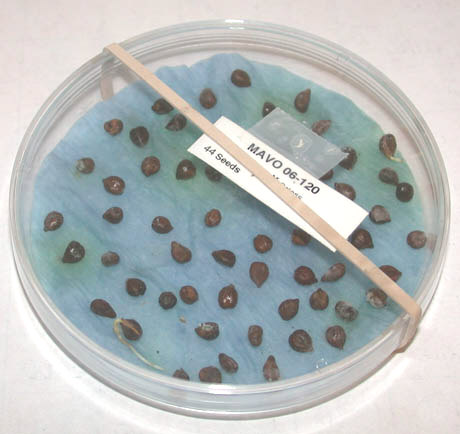
Grapebreeders Home Page
Photos of Germinating Grape Seeds at Mt. Ashwabay Vineyard & Orchard - 2007
Written
by Mark Hart.
The blotter method of seed germination is
one option for starting grape seeds. In this method seeds are put on a moist
blotter, allowed to just start to germinate, and then removed individually and
put into some kind of pot with soil or growing media. The primary advantage
over other methods is that the space and time required to pot a seed is only
performed on those seeds that actually start to grow - which may be only a fraction
of the total seeds. As with other germination methods, the seeds are given
a moist startification (80-90 days in the refrigerator, 1 C, at MAVO); soaked
for 8-24 hours in water or dilute (3%) hydrogen peroxide; surface sterilized
in laundry bleach, diluted 4:1, for 10 minutes; and then double rinsed (with
agitation) in distilled (near sterile) water.


Above Photos: A moist paper blotter (Scott Contractor Paper
Towels cut to fit) in sterile disposable plastic Petri dish. Specially
made germination paper is available,
but the heavy paper towels seem to work quite well. The blotter is wetted initially
to the point just shy of there being 'free' water in the dish. The blotters
are periodically re-wetted during germination, as the blotters will slowly dry
out. Grape seeds will not all prount synchronously, but over about a 10
day period for a seedlot. Germination dishes needed to be checked every few
days to remove the sprouted seeds, as the new root will often start to die if
it gets too big or dry in the blotter environment.
Don't put too many seeds in a dish, the amount shown is near
the limit (no touching seeds). Notice two geminated seeds in the photo, ready
to plant into the plant bands
(bottomless paper pots). Seeds with a growing root (radicle) are removed with
tweezers and gently planted into the growing media. The seed portion is positioned
closest to the surface, and can be buried to a depth of not more than 1"
(1/8 to 1/4" at MAVO).
The biggest problem with this method is that fungi and mold will grow on the surface of the seeds (see photos below). The seeds should be as clean as possible before putting them in the dishes. In addition a fungicide can be used to discourage fungal growth. The active ingredient azoxystrobin has proved useful at MAVO, and mefenoxam is another good one to try. Keep the dose low, if you apply it with each re-wetting, the concentration will get higher overtime on the blotter. Techniques or chemicals that are used against damping off fungi (Pythium, Phytophthora, etc.) are good candidates to try. Be careful, some chemicals are too harsh for the very young roots - test first.
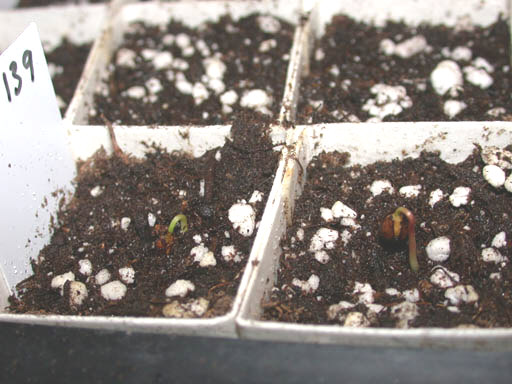
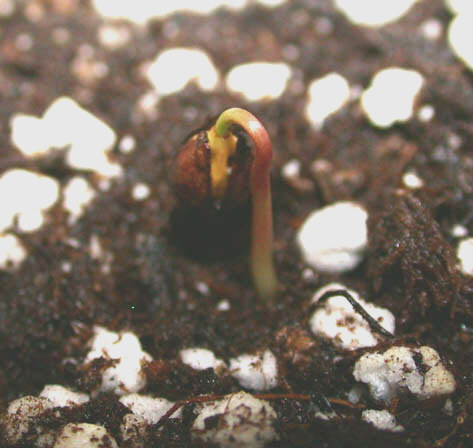
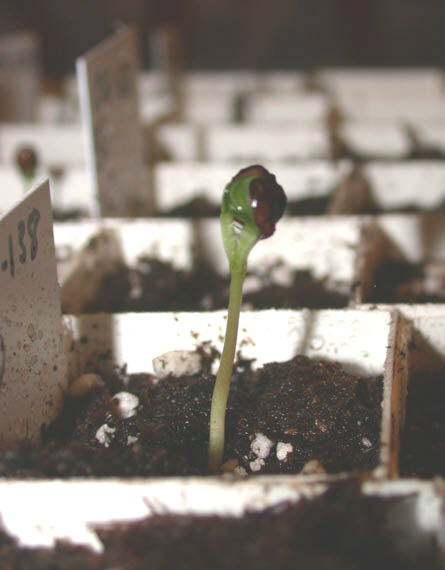
Above Photos: Seedlings emerging from the media in the plant
bands; first the elbows, then the cotyledon leaves, which have to pull out of
the seed coat. Seedlings usually start to break through the soil surface about
5-8 days after being placed in the pots - depending on planting depth and the
size when transplanted from the dishes. In the photo on the left you can
see the normal 'triple split' in the seed coat. In this photo the outer seed
coat is separating well, but the inner seed membrane (orangish in photo) is
still intact. Not infrequently the seedlings will retain the seed coat on the
cotelydon leaves for a number of days after they emerge. Usually the seedlings
will eventually get out on their own. If you try to assist in the seed
coat removal, you will often tear the very tender leaves inside. The seedling
in the photo on the right took almost 5 days to come free of its coat, which
it did only moments after the photo was taken
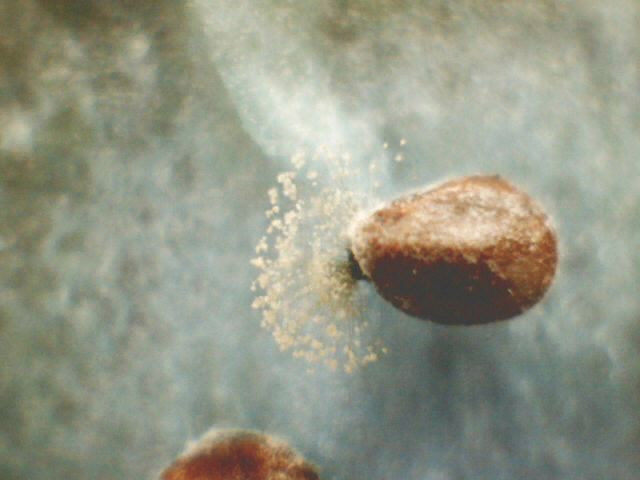
Above: A fungal 'bloom' that seems to originate from a 'barnacle'
on a grape seed. These structure are probably the fruiting bodies of the Botrytis
fungi, and the sporulation (bloom) is initiated by being put in the moist dish
environment.
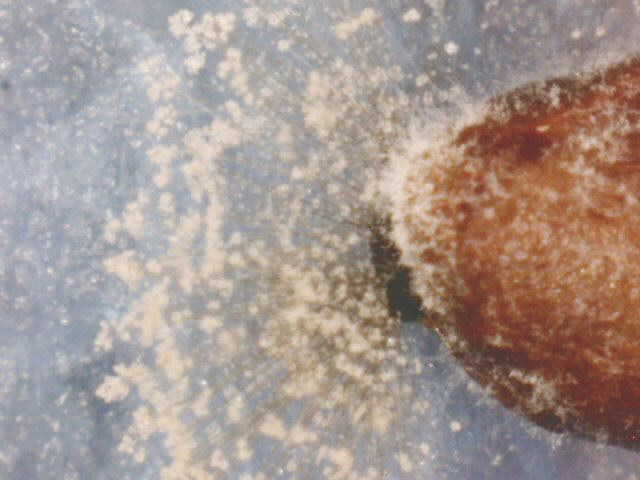
Above: A close-up of the fungal 'bloom'
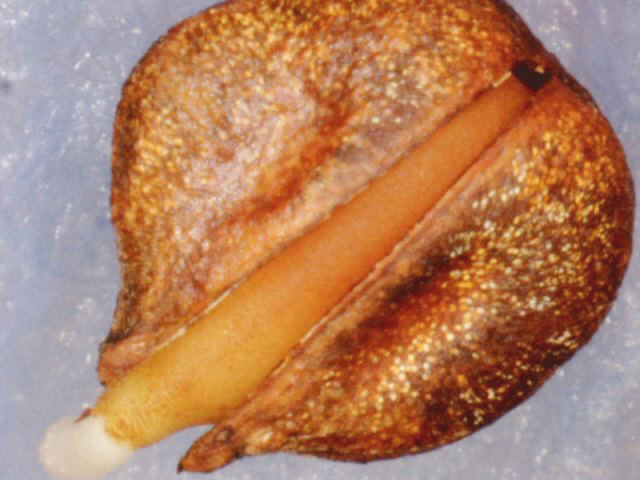
Above: A close-up of a seed that has germinated, with the root radicle growing downward (away from the camera) toward the filter paper
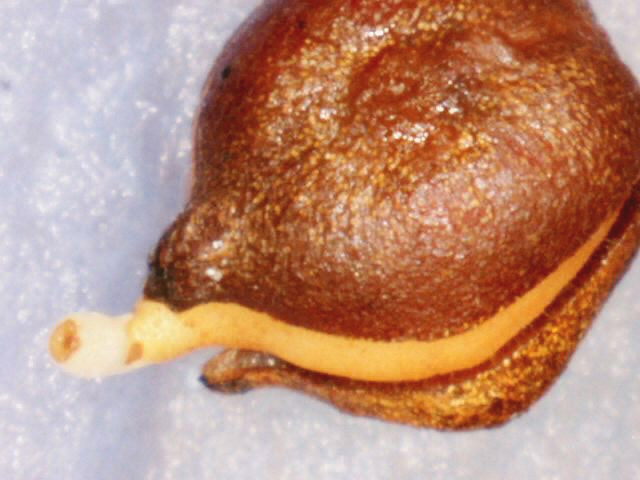
Above: A close-up of a seed that has germinated, turned over, with the root radicle pointed towards the camera.
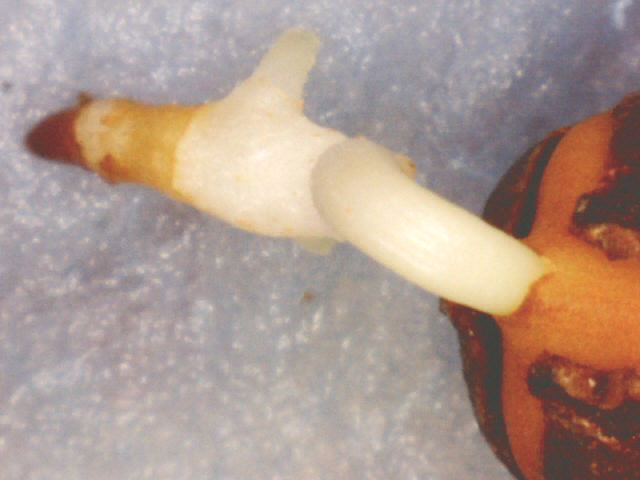
Above: A view of a longer radicle from a grape seed. In this case, the tip of the radicle was accidentally killed by exposure to a bleach surface rinse (seed started to germinate in stratification). The radicle is showing the initiation of a branch root above the portion killed by the bleach exposure.